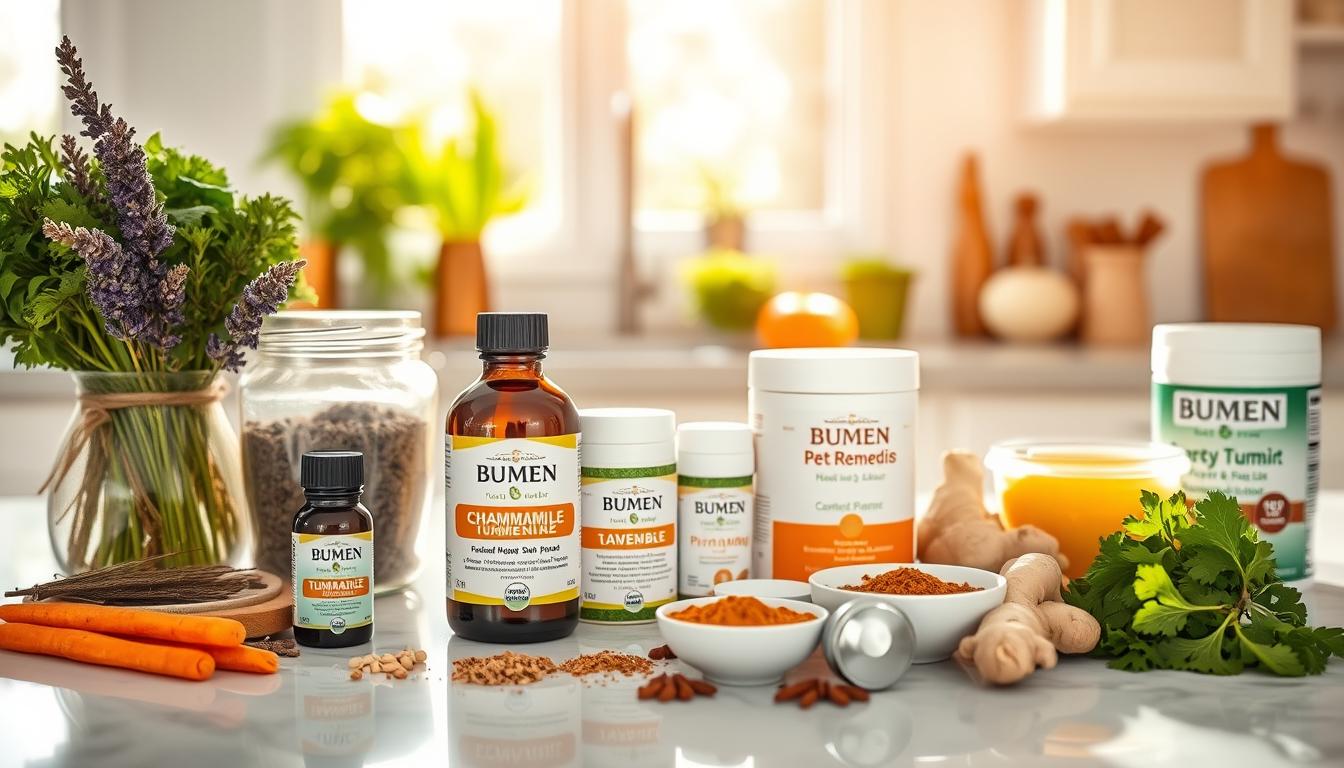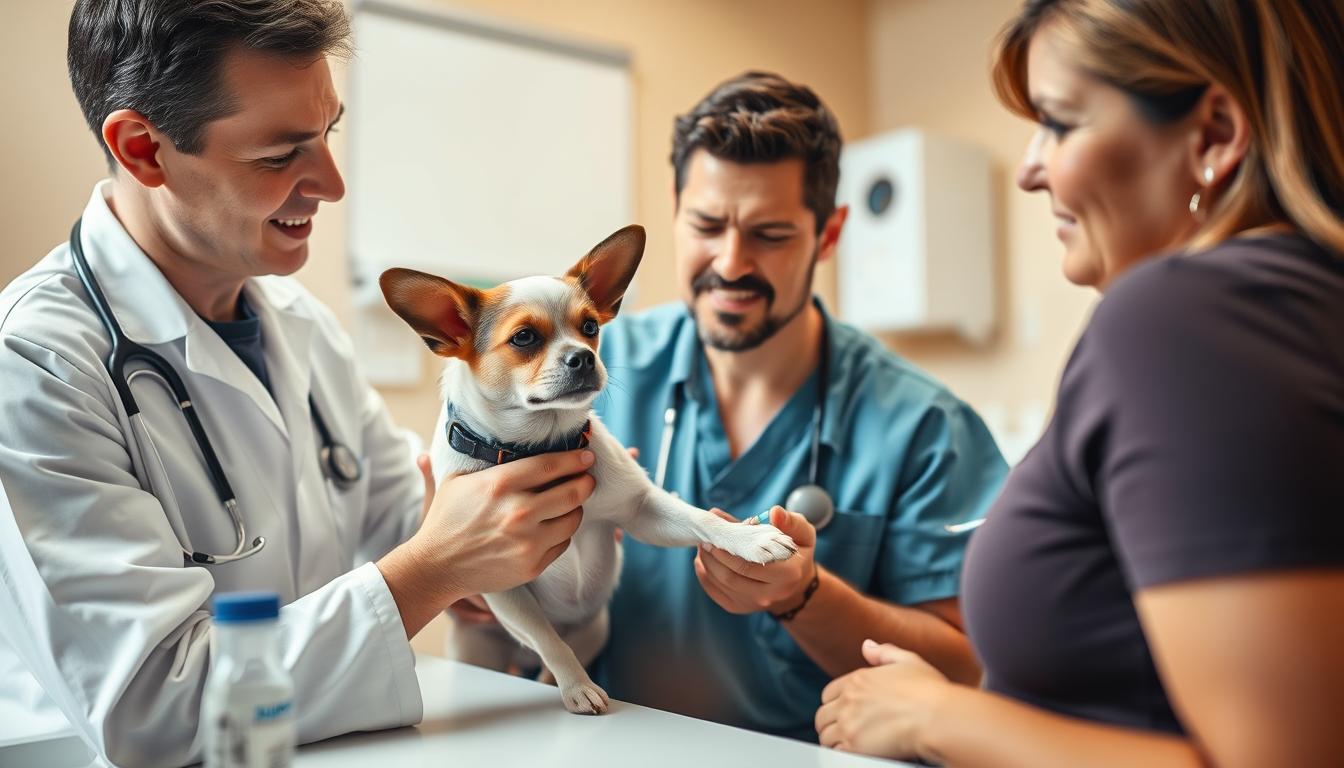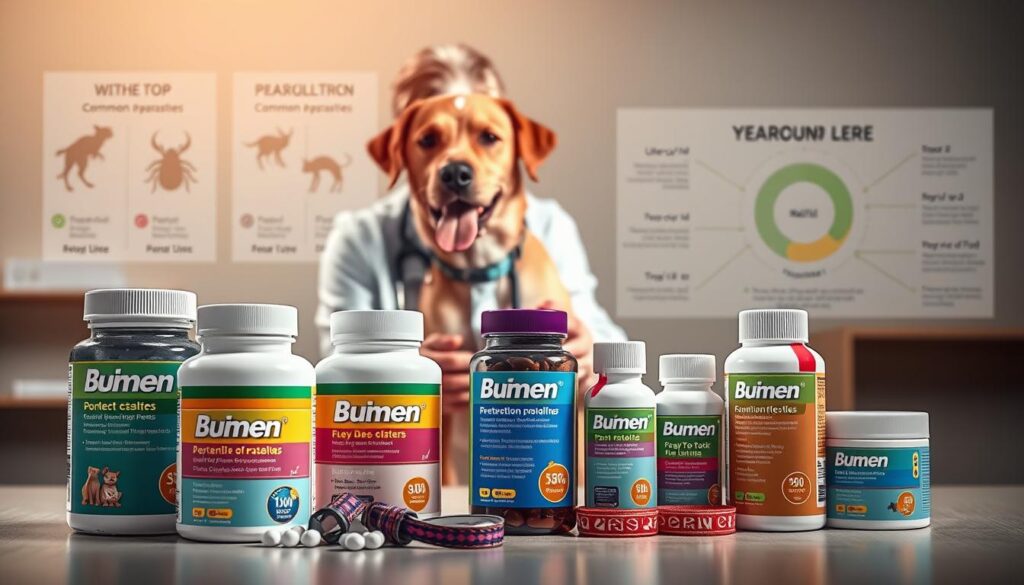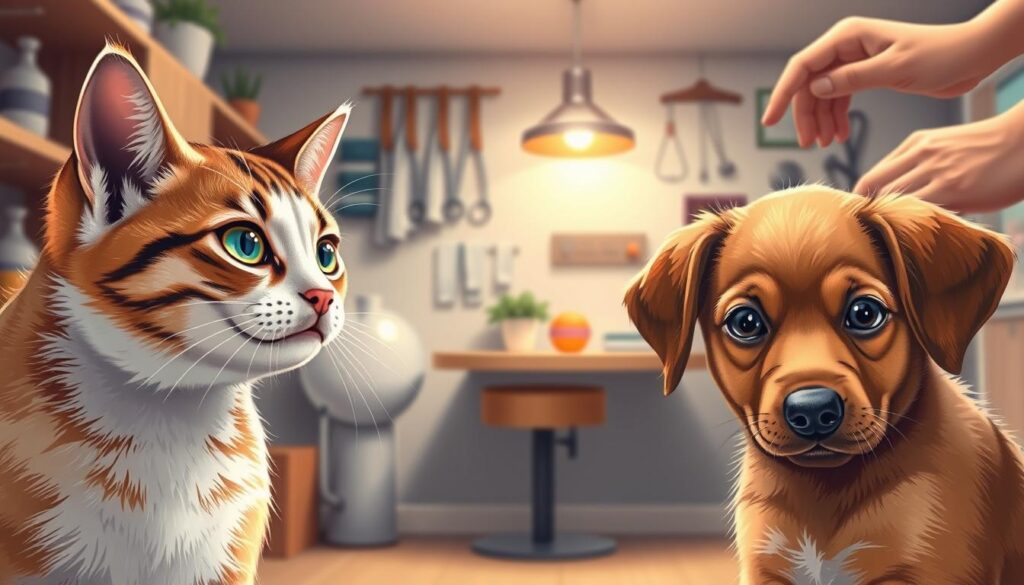When your pet’s paw pads crack, their stomach churns, or their ears itch, you want to help. Home remedies offer gentle, easy ways to ease their discomfort. They help until you can get to the vet.
Imagine giving your pet a cooled oatmeal bath for a rash or plain yogurt for a tummy ache. These moments are more than just fixing problems. They’re about building trust with your pet.

This guide shows you safe, effective solutions for dogs, cats, and small pets. You’ll learn to use honey, coconut oil, and apple cider vinegar to help your pet. Each tip combines natural remedies with pet care science, so you can act with confidence.
Let’s turn those worried moments into chances to bond and keep your pet comfortable.
Why Natural Solutions Matter for Your Pet’s Health
Choosing natural pet remedies can change how you care for your pet. These homemade solutions often don’t have synthetic additives. This reduces the risk of allergic reactions or side effects.
Using items from your pantry also saves money. It provides gentle, effective care that’s tailored to your pet’s needs.
Benefits of Choosing Homemade Treatments
- Safer alternatives to chemical-heavy products
- Cuts costs compared to store-bought options
- Allows customization for your pet’s specific health needs
Common Ingredients Found in Your Kitchen
| Ingredient | Use | Example |
|---|---|---|
| Coconut Oil | Skin and coat support | Mix into food for dry skin relief |
| Apple Cider Vinegar | Ear cleaning solution | Diluted with water for mild antiseptic action |
| Oatmeal | Soaks for itchy skin | Ground oats in bathwater for allergy relief |
Safety Considerations Before Starting
- Consult your vet before trying new remedies
- Always test small amounts first
- Avoid toxic foods like onions or chocolate
Remember, natural pet remedies work best with professional advice. Always put your pet’s safety first when trying these simple, accessible options.
Soothing Your Pet’s Skin Allergies and Irritations
Itchy skin, redness, and rashes can really bother your pet. Many skin problems come from allergies or things in the environment. But, homemade pet treatments can help gently. First, figure out what’s causing the issue—like pollen, flea bites, or cleaners.
Oatmeal baths are a great fix: just grind oats into a powder and mix with warm water. This makes a soothing bath for your pet.
- Coconut oil is a natural moisturizer that helps with dryness when used on the skin.
- Apple cider vinegar mixed with water can help balance your pet’s skin pH and fight fungus.
- Witch hazel is good for reducing inflammation without using harsh chemicals.

To stop problems, clean your pet’s paws after walks to get rid of allergens. Brush them often to remove loose fur and spread natural oils. Stay away from products with perfumes or dyes that can irritate their skin.
Dogs with thick coats, like Golden Retrievers, might need a weekly oatmeal bath. Fluffy cats might do better with a gentle wipe-down using a damp cloth with chamomile tea.
Watch how your pet reacts to any treatments. If things get worse or don’t get better in 48 hours, see a vet. Use homemade pet treatments along with a vet-approved diet for better skin health. Be extra careful with small breeds or pets with short hair when using topical treatments.
Effective Home Remedies for Common Pet Health Issues
Every pet has its own health needs. Use these safe, species-specific solutions with everyday items. Always check with your vet first.
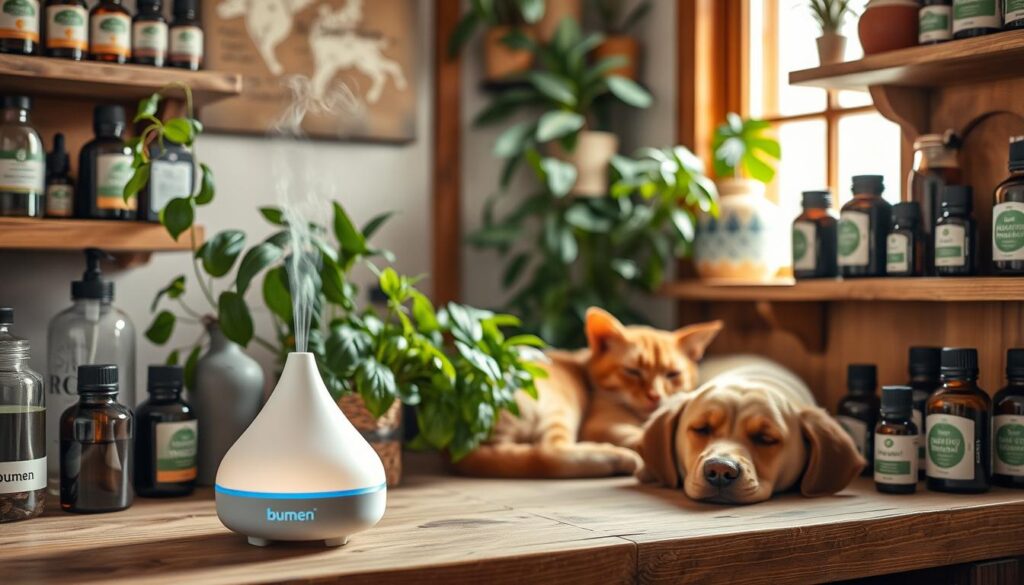
Remedies for Dogs
- Hot Spots: Soothe irritated skin with a cooled chamomile tea soak. Pat dry gently.
- Paw Irritations: Rinse paws in a mixture of 1 part apple cider vinegar to 4 parts water to reduce inflammation.
- Anxiety: Offer a stress-relief snack made from 1 tsp peanut butter mixed with a probiotic capsule.
Remedies for Cats
- Hairballs: Mash a small amount of pureed pumpkin into meals to aid hairball passage.
- Urinary Issues: Add ¼ tsp cranberry powder to water daily to support urinary tract health.
- Flea Deterrent: Rub diluted citrus oil (10 drops lemon essential oil + 2 tbsp coconut oil) onto a cloth near your cat’s bed.
Solutions for Small Mammals
- Soft Poop: Offer a small slice of plain, unsweetened applesauce to firm up droppings.
- Respiratory Issues: Place a steamy bowl of water near the cage for 10 minutes twice daily to ease congestion.
- Overgrown Teeth: Supply edible wood chew toys designed for rabbits or guinea pigs to naturally file teeth.
Tackling Digestive Problems with Kitchen Ingredients
When your pet’s stomach is upset, try natural pet remedies and diy pet healthcare. Many common digestive issues can be fixed with items from your pantry. First, understand your pet’s symptoms and see a vet if they don’t get better. Here’s how to use everyday ingredients safely:
Natural Solutions for Upset Stomachs
- Pumpkin puree (unsweetened) soothes irritation and adds fiber. Offer 1 tsp per 10 lbs of body weight.
- Plain Greek yogurt with live cultures provides probiotics. Give ½ tsp to small pets, 1 tbsp for larger dogs.
- Chamomile or ginger tea (cooled) in small amounts can calm nausea. Avoid caffeine-containing herbs like peppermint.
Remedies for Constipation and Diarrhea
- For constipation: Mix ½ tsp psyllium husk powder (NOW Foods) with wet food. Always add water to prevent blockage.
- Diarrhea relief: Combine boiled rice with bland chicken and a dash of electrolyte solution like Pedialyte.
- Applesauce (unsweetened) restores hydration. Use 1 tsp per 5 lbs of body weight.
Herbs That Support Digestive Health
Incorporate these gently in consultation with your vet:
- Slippery elm bark (Nature’s Answer) forms a protective lining in the gut.
- Ginger tea (steep 5 minutes, strain) aids motion sickness and bloating.
- Fennel seeds (ground) can be sprinkled on meals to ease gas—use ¼ tsp for cats/dogs under 20 lbs.
Always adjust portions based on your pet’s weight and vet guidelines. Prioritize quality ingredients and monitor reactions closely.
Managing Your Pet’s Ear Issues Naturally
Ear troubles can make your pet uncomfortable. But, diy pet healthcare has gentle solutions. Mix equal parts water and apple cider vinegar or witch hazel in a clean bottle. This mild solution helps reduce irritation and moisture buildup.
- Wipe outer ears with a cotton ball soaked in the solution.
- Avoid inserting anything into the ear canal—always clean gently around the folds.
- Dry thoroughly after baths or swimming to prevent yeast growth.
Homemade pet treatments are best for mild cases. They work well for post-swim moisture or minor wax buildup. Always check for redness, odor, or head-shaking. If these signs last, see a vet—signs like pus or extreme sensitivity mean it’s time for professional care.
Make weekly cleanings a part of your routine to prevent issues. Never use alcohol-based products, as they can irritate sensitive skin. Always watch your pet’s reaction and adjust solutions as needed.
Holistic Approaches to Pet Dental Care
Healthy teeth and gums are key for your pet’s health. Holistic care offers safe ways to keep their mouth clean. Simple steps like brushing and changing their diet can prevent vet visits and boost their health.
DIY Teeth Cleaning Solutions
Begin with a soft cloth or finger brush for daily teeth cleaning. Mix coconut oil with baking soda for a safe paste. Give treats to make brushing fun. For more help, try dental sprays like TropiClean or Vetoquinol’s.
Natural Breath Fresheners
- Give fresh parsley sprigs as a breath-freshening snack.
- Soak a cotton ball in diluted apple cider vinegar and wipe gums weekly.
- Avoid mint or alcohol-based products that irritate sensitive mouths.
Preventing Dental Issues Long-Term
Use dental chews like Greenies or C.E.T. enzymatic treats to remove plaque. Offer hard vegetables (carrots) and toys with textured surfaces for natural cleaning. Fish oil supplements reduce inflammation, and crunchy kibble helps remove tartar. Regular vet visits help catch issues early.
Adding these habits to your daily routine helps maintain your pet’s oral health. Holistic care focuses on your pet’s comfort and promotes lifelong dental health without harsh chemicals.
Easing Joint Pain and Mobility Issues in Aging Pets
As pets get older, they may feel stiff and uncomfortable in their joints. This can make simple activities hard for them. Luckily, there are gentle ways to help them stay active.
Start by adding anti-inflammatory foods to their meals. Omega-3-rich salmon or turmeric blends are great options. You can also try supplements like glucosamine and chondroitin. Brands like Dasuquin or Cosequin are known to improve joint health.
Try gentle massage on sore joints with warm hands in circular motions. This can help improve blood flow. Use non-slip mats on stairs or orthopedic beds to ease pressure.
Short walks or swimming are also good for keeping your pet mobile. These activities are easy on their joints.
- Supplements: Fish oil, MSM, and green-lipped mussel powders.
- Comfort aids: Raised food bowls and heated pads approved for pets.
- Exercise tips: 10-minute sessions of slow walking or indoor play.
Remember to check in with your vet regularly. Small changes can make a big difference. They can help your aging pet move more easily and enjoy their golden years.
Natural Remedies for Minor Wounds and Hotspots
Minor scrapes or hotspots can be treated safely at home. Use gentle cleansers and soothing ointments to help pets heal. Make sure to check the wound first. If it gets worse, like redness spreading or swelling, see a vet.
Cleansing Solutions That Don’t Sting
- Calendula tea soak: Steep 1 tbsp dried calendula flowers in 2 cups boiling water. Cool completely and soak gauze for gentle cleaning.
- Saltwater rinse: Mix 1 tsp non-iodized salt in 1 cup filtered water. Use a syringe to flush debris from wounds.
Creating Effective Healing Salves
Mix these ingredients in a small jar:
- 2 tbsp beeswax pellets
- 1/2 cup coconut oil
- 5 drops tea tree oil (for dogs only—never use on cats)
- 1 tsp raw honey (use only for dogs)
Melt ingredients in a double boiler, stir, and let cool. Apply a thin layer twice daily.
Preventing Your Pet From Licking Wounds
- Bitter apple spray: Mix 1 part lemon juice with 3 parts water in a spray bottle. Spritz around wounds hourly.
- Distraction tactics: Offer puzzle toys filled with peanut butter or freeze-dried chicken to keep paws busy.
- Epsom salt paste: Create a thick paste with water and apply to paws to deter licking.
If wounds show signs of infection (pus, fever) or don’t improve in 48 hours, stop treatments and seek professional care. Always pair natural remedies with vet checkups for persistent issues.
When to Skip Home Treatments and Call Your Veterinarian
DIY pet care can handle small problems. But, knowing when to call a vet is key to keeping your pet safe. Serious signs mean you should act fast—don’t wait if your pet’s health is in danger.
Warning Signs That Require Professional Care
Look out for these warning signs and call your vet right away:
- Labored breathing or rapid panting
- Uncontrolled bleeding or severe swelling
- Seizures or sudden paralysis
- Continuous vomiting or diarrhea for over 24 hours
- Loss of consciousness or extreme lethargy
Combining Conventional and Natural Approaches
Many vets support holistic pet care when done right. Here’s how to do it:
- Talk to your vet about DIY remedies first
- Share your pet’s health updates during vet visits
- Make sure to get regular check-ups
Always get professional advice for ongoing or getting worse problems. Trust your gut—if something seems wrong, get help immediately.
Building a Natural Pet Care Routine That Works Year-Round
Starting a holistic pet care plan is all about having a year-round strategy. Instead of reacting to problems as they come up, create routines that match your pet’s needs for each season. For example, summer might be the time for cool oat baths to soothe itchy skin. Winter, on the other hand, could be when you add joint supplements to help with stiffness.
Make sure you have a special place for all your pet care items. Keep things like coconut oil, aloe vera, and probiotics in airtight containers. This keeps them fresh and effective.
Preventing health issues is key. Feed your pet a balanced diet full of omega-3s and avoid processed foods. Regular exercise, like walks or playtime, keeps their joints moving and their energy up. Keep track of how your pet reacts to new remedies. Then, adjust their care based on what works best for them.
Remember, every pet is unique. Try out different natural health remedies, but always talk to your vet first. By combining these approaches, you can help your pet stay healthy and happy. Small changes now can lead to a lifetime of wellness, saving you money and strengthening your bond with your pet.
